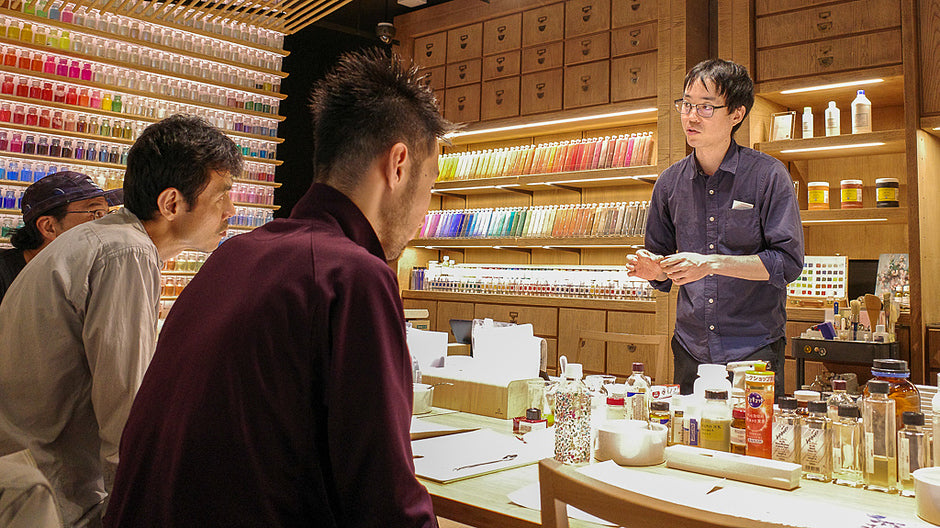PIGMENT TOKYO is a creative laboratory that explores the "expression of color and matière," while at the same time, it is also an alternative space for workshops, exhibitions, and an art supply store.
We have a unique approach to research, education, and dissemination of painting materials, such as pigments, animal glue, paintbrushes, etc. We focus on their usage and the expression of these materials, and the result created by combining these two approaches.
In addition to researchers and artists with a deep knowledge of painting materials and colors, the team has creative directors and producers whose profession is connecting art and business, therefore, PIGMENT TOKYO also functions as an art studio that provides technical support and project proposals to companies in Japan and abroad.

In order to meet the diverse needs of artists, requests for bulk buying are now available in PIGMENT TOKYO.
https://pigment.tokyo/en/pages/contact?large_orders=selected
As part of these projects, "PIGMENT TOKYO Material Conference Vol. 1" was held as a new event to strengthen the function of connecting artists and materials.
This is a project to invite artists based in Japan to experiment with art materials available in our lab guided by art materials experts.
The guests for the first event were Hideyo Ohtsuki, Ryosuke Ogino, and Yusuke Mitsufuji.
Let’s see what materials draw their attention the most.
First, one of our PIGMENT TOKYO's art material experts, Kei Saito, introduced the concept of the lab and the art materials available in the store. He explained each detail of pigments known as coloring materials, such as tube paints, YInMn Blue, and effect pigments.

During the tour, our guests were taking notes on their smartphones.
Mr. Mitsufuji saw the sample book of the effect pigments and said, "This is very thoughtful!”

Later, they were introduced to the display of metal leaves.
They are also interested in Saiboku (colored inksticks) which are not seen very often.
After the lecture on the connection between pigments and paints and how to make paints, the guests had some time to experiment with art materials that can be applied to their own practices.

Mr. Ohtsuki was using AQYLA paints on glass and saying “I’ve always wanted to try painting on substrates like glass!" He also mentioned seeing AQYLA paints at art supply stores but this was his first time using them. “Look how beautiful these colors stay on the glass!" said Mr.Ohtsuki while trying on different colors.

AQYLA paints can be applied directly on paper and canvases as well as metal and glass.

Mr. Ohtsuki testing the YUPO paper. Mr. Ogino said, "The surface peels off like the skin of a dried squid, so I think I can use it for three-dimensional works as well!”
The great thing about this event is artists can discover new aspects of art materials through conversation and interactions.
Mr. Ogino, who usually uses acrylic paints in his work, tried original handmade paints that are a mixture of pigments and acrylic mediums on various substrates. He usually paints only on canvas, so he carefully observed the changes in texture created by the plaster ground, silk canvas, and so on.
Moreover, he later experimented with bleaching techniques using masking ink.



The blue-green part is masking ink, which can be removed with an eraser after it has completely dried to create a clean white background. As Mr. Ogino said “This could be used for my projects," there might be a possibility of using it in his next work.
On the other hand, Mr. Mitsufuji usually uses pens as his drawing tool, so he started experimenting with the Yupo paper as well. He observed how ink bleeds and the color saturation of Zecchi's cochineal ink with other pigment ink and dye ink pens that he brought.
Furthermore, he was offered to try the same ink pens on different substrates such as silk and plaster, and later he found out the colors varied depending on the base materials.
These discoveries are not only exciting for the participants but also new to PIGMENT TOKYO's staff.



These are plasterboards and silk canvases. The colors work amazing on both substrates.
In the last part, there was a demonstration of techniques that are not likely seen in other art supply stores such as mixing techniques using AQYLA and oil paints and how to make semi-water-based paints using surfactants.

In the end, our guests were given a PIGMENT TOKYO’s original souvenir set to take home with them.
It was a great opportunity to hear what professional artists are thinking every day and receive feedback from them such as “I wish I had tried more mediums” and “I feel art materials experts are so valuable”.

Although this event is by invitation only, PIGMENT TOKYO has experts who are knowledgeable about various kinds of art materials, therefore, feel free to visit us if you have any questions on art making or struggling with exploring new expressions in your art practice.
Translated by Atsumi Okano and Nelson Hor Ee Herng
PIGMENT TOKYO Art Materials Experts

